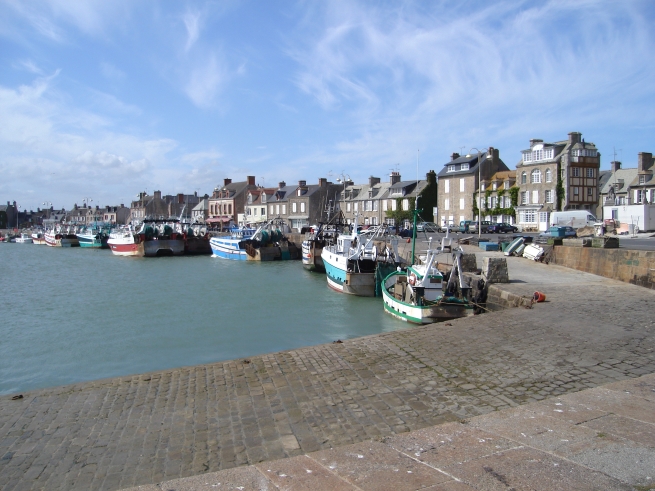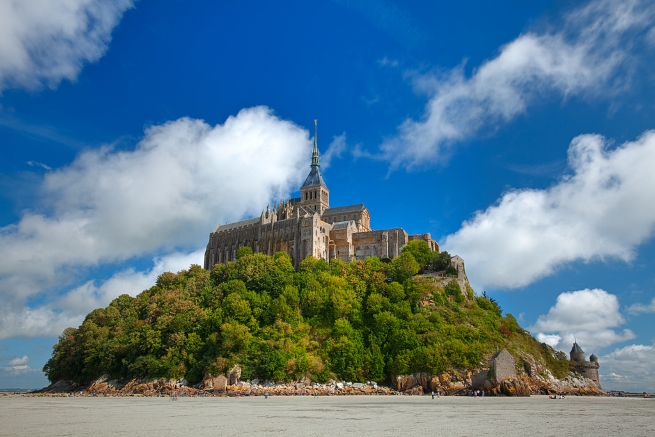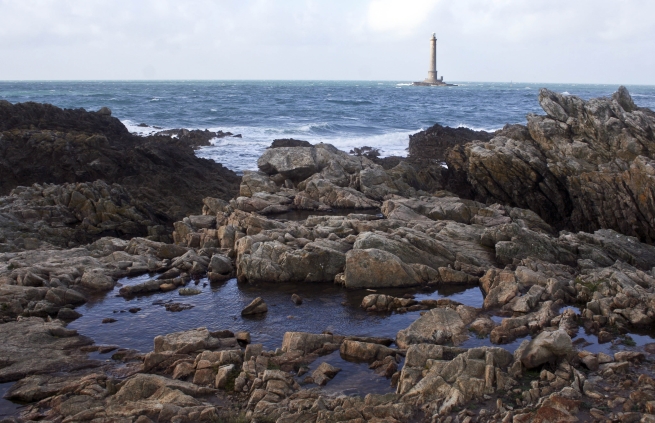Manche

France Today takes a tour around this department
Before deploying adjectives and gushing superlatives to evoke the many-splendoured appeal of La Manche – the hunk of land that sticks out of Lower Normandy towards Britain like a gnarled hand, the Cotentin Peninsula its pointing finger – here are some cold, hard facts to set the scene.
Not only is it France’s 50th département size-wise and numbered 50 for administrative purposes, but head inland from its rocky, village-dotted coastline and you will never be more than 50 kilometres (31 miles) from another sea view. Consider, too, that to support its economy it has the largest number of farms (18,200) of any French département, and you get some idea of the place.
The figures are memorable, sure, but after paying a visit here, it won’t be statistics that you quote upon your return. More likely, it will be images of stunning vistas (both watery and dry), historical architecture and hearty rustic food that fill your post-holiday anecdotes.
Anyone with even the vaguest of Francophilic tendencies will have heard of two of La Manche’s key tourist spots. The first is among France’s finest landmarks: Mont-Saint-Michel, the off-shore, abbey-topped island that sits in the Bay of Saint-Malo (more of that later). But equally familiar to most is the common point of entry into France, and an obvious starting point for a clockwise tour of the region, namely the port of Cherbourg at the northern tip.
A vital, if unmemorable, thoroughfare for many Loire-bound ferry travellers, this town of 25,000 inhabitants houses one of the world’s largest artificial ports and played a major part in the D-Day landings (it was the only deep port in the region). The town may have lost much of its finest architecture to German bombing – it is considerably less charming than the 1964 film The Umbrellas Of Cherbourg would have you believe – but it is still worthy of a day’s wandering. You could follow a morning’s browsing at the lively Place de Charles de Gaulle market with a fresh-as-can-be seafood lunch at the pretty Avant Port and an afternoon look at the Musée Thomas-Henry, home to many works by local legend Jean-François Millet. Alternatively, visit the new Cité de la Mer submarine and underwater exploration museum that opened last spring.
After that, leave the region’s biggest town and head for its smallest village, Barfleur on the Cotentin Peninsula’s eastern seaboard. Cutesy, scenic Barfleur has the look of a fishing village that clings for dear life to dry land after decades of windy, rainy abuse and a threatening sea. Six thousand people once lived here, but now that figure is less than 700, lending a cool ambience and peaceful air to the granite building-lined harbour. The village did, however, play a key part in history, for it was here that a local man, Etienne, built and steered the Mora, the boat that carried William the Conqueror to England in 1066. To ponder this episode in Anglo-French relations, for sustenance before continuing your travels, or simply to shelter from salty gusts, head for one of the restaurants on Rue Saint-Thomas Becket.

Barfleur, photo: Jean Melis
More reminders of less peaceful times can be found at Sainte-Mère-Eglise, due south of Barfleur and inland from Utah Beach. The dummy of a parachutist seen dangling from the clock is an enduring image, evoking the morning of June 6 1944, when US trooper John Steele drifted in on a mercy mission. A visit inside the 12th-century church is a must and, with war heroics in mind, follow up with a worthwhile sojourn further inland to central La Manche, the bocage country that was used to such great effect by the defending Germans during World War II. This emerald patchwork of trees and bushes, criss-crossed by hedgerows, has stayed unchanged for centuries, and the varyingly hilly, iron-flat and marshy land is dotted with old farmhouses, the skyline punctuated by church steeples.
Agriculture dominates life here, from milk production to beef rearing, and this is unquestionably the best place to hire a bike and enjoy the living countryside. Along the marked trails of the Cotentin and Bessin Marshlands Regional Park, for example, you can cruise the backwaters, sucking in the pure air and spotting the famously pretty Normandy cows, with their unique panda-like eye markings. As a back-to-nature experience, it takes some beating.
Exercise should be rewarded with a glass of something boozy and invigorating. In La Manche, that means only one thing: cider. Normandy makes no wine, so most meals should be washed down with a glass of local stuff, most of which is either bouché (corked and fermented in the bottle) or mousseux (naturally carbonated).
On no account should this region be visited by anyone intending to lose weight. Rich, tasty and compellingly fresh, the produce here is designed to be used in old-school French cooking, with cream and butter atop the list of ingredients and the needs of dieters at the bottom. Essential foodstuffs from the region include prized butter from Sainte-Mère-Eglise, oysters from the Cotentin Peninsula, salt lamb and omelettes from around Mont-Saint-Michel and tender beef from Normandy cows. And if you want to try regional recipes when you get home, why not cook using authentic copper pans from Villedieu-les-Poêles (literally ‘God’s town of the pans’), the capital of cookware in southern La Manche? After a visit to one of the copper workshops or bell foundries, you can buy pans at great prices in factory shops.
Continuing the loop of La Manche, cut across the rustic Mortainais area from Villedieu to the town of Avranches, which perches above the Bay of Mont Saint-Michel. The island may be over 10 miles away, but the breathtaking views afforded from the town’s public gardens, plus a viewing of eighth-century abbey manuscripts in the town hall library, provide an exciting teaser before the main event.

Mon Saint Michel, photo: Nicolas Raymond
Famed in equal measure for its mish-mash of architectural styles and spire-crowned medieval abbey as for the amazing tides that caress its giant granite base, the first sighting of Mont-Saint-Michel is awesome, and provides many people with their enduring image of Normandy. The abbey took 500 years to build and, since completion in 1521, it has seen many tweaks and improvements. It was fortified at the end of the 14th century, became a prison after the Revolution and the gilded statue of Saint Michael was added in 1897. Monks have lived there on and off for centuries and visitors can join them for daily mass today.
There are myriad ways to get to the island, from horse-drawn carriage to coach, by pony or by foot, and the wheels of the tourism machine are very well oiled. Taking a guided tour is a good idea, not only to learn of the place’s history, but also because of the rapidity with which the tide rises. As a safety precaution, it is best not to trust your own judgement, as legend has it that the water rises 15 metres from low to high tides at the speed of a galloping horse. Six miles per hour is a more likely, almost as impressive figure. After buying a tacky souvenir from one of the shops on Mont-Saint-Michel’s frenetic main street, you could try one of the famous fluffy omelettes from La Mère Poulard before heading to the abbey summit for some tranquility. Finally, a night visit to the island is a great idea. Not only will you avoid the crowds, but you will also witness the beautifully conceived illuminations.
Heading northwards up the western side of La Manche, there are two essential stop off points. The first, Granville, is a port with the self-awarded nickname ‘Monaco of the North’. The comparison is both geological – Granville is clustered on a rocky promontory with new buildings down below – and social, since in summer the monied, thrill-seeking hordes head there to play around on yachts. In keeping with the air of chic, the town is home to Christian Dior’s childhood home, now an excellent fashion museum. Further up the coast is the medieval hilltop town of Coutances, whose main pull is its superb Gothic and Romanesque 13th-century cathedral.

Cap de la Hague, photo: Morburre
To close the La Manche loop, head north to the Cap de la Hague, a wild, sparsely populated coastline that is perfect for getting away from it all, before returning to the ferry at Cherbourg. The goats and cows that graze cliff-top pastures around the Nez de Jobourg, Port Racine and Baie d’Ecalgrain while the Atlantic pounds the white rocks below probably do not know how lucky they are.
OUTINGS
Sainte-Mère-Eglise, the most famous site of the D-Day parachute landings, is home to the excellent Musée Airborne, which has a permanent collection about the US air drop on June 5 and 6 1944.
Hiring a bike is the best way to see the beautiful countryside of the Cotentin and Bessin Regional Park. Head for the Carentan Tourist Office for details of bike hire.
One of the best places to buy luxury pans in Villedieu-les-Poêles is at the Atelier du Cuivre. Looking around the workshop costs just 4 euros. The price includes a short film, in English, recounting the company’s history.
For a complete history of Mont-Saint-Michel, go to see the abbey archives in Avranches. For a close-up look at Mont-Saint-Michel.
CONTACTS
For more information about La Manche, contact the Manche Tourist Board.
CLIMATE
The region has July averages of 19ºC and January averages of 5ºC, with moderately strong ocean winds.
Share to: Facebook Twitter LinkedIn Email
Leave a reply
Your email address will not be published. Required fields are marked *



